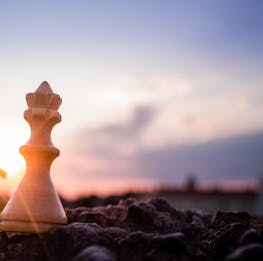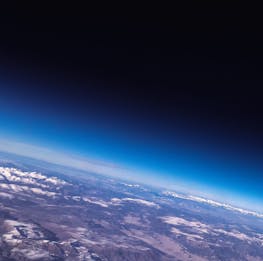A Short History of Nearly Everything Summary
A journey into the most intriguing and intractable questions that science seeks to answer
How did it all begin, and how did we get here?
A Short History of Nearly Everything, weaves together history and science, to offer a relatively concise, and extraordinarily comprehensive answer to these enormous questions. This guidebook on science takes us from the beginning of the universe, to how humans came to inhabit it.
Most of us are familiar with Bill Bryson as a consummate storyteller and travel writer. While A Short History of Nearly Everything is a bit of a departure from his travel writing, in many ways, it's a journey through the history of scientific discovery. We're invited to embark on an incredibly absorbing adventure into the often dry and daunting world of science. Armed with his wry wit, a penchant for veering down rabbit-holes, exceptional research, and trademark ability to bring content to life, Bryson delves into time and space.
This is a book about how it all happened. It's about how out of nothing, something emerged, and that over time, that something became the vastness that is life on Earth and the universe beyond that. Even if you're not passionate about science, this is the one book that might convince you that there's more to the subject than learning the periodic table, and grappling with complex equations. So fasten your seatbelts as we briefly journey from the very beginning, to a place that has no end.
Atoms
What makes you unique and so specifically you?
All too often, we just exist in our everyday lives without realizing how utterly extraordinary we are, from a scientific perspective.
Humans are a wonderful combination of cells and DNA, but if we adjust the lens even more, we're made up of a unique collaboration of trillions of atoms. We don't usually interrogate how our bodies are actually made up, unless we find ourselves in a particular learning environment, or suffering from an illness. The fact is that our bodies, and everything else as we know it, are made up of atoms.
Atoms are made of protons, neutrons, and electrons, and they're the particles that form everything around us. The sky, the ground, water, the chair you're sitting on, all material things – are made up of atoms. But here's the truly fascinating thing about atoms. They're recyclable, they're durable, and they're abundant. Bryson suggests, 'Every atom you possess has almost certainly passed through several stars and been part of millions of organisms on its way to becoming you.' In short, we're all reincarnations of different variations of atoms, and when we die, our invisible atoms scatter, move on, and latch on to other atoms to form a multitude of other things.
Basically, it all started with atoms. From absolutely nothing, the universe as we know it came into existence.
The Recipe for a Universe
It all began with nothing. Before we got here, something extraordinary happened; the universe appeared, and it came from nothing.
It's so difficult to conceptualize this because nothing is a relational concept. We understand nothing in terms of the binary "something." So let's try to wrap our heads around this.
Imagine, if you can, a tiny dot filled with billions and billions of protons. (Remember that protons are a minuscule part of an atom.) You're probably imagining the dot surrounded by something, aren't you? Perhaps it's a dot on a piece of paper, or simply just a dot floating around somewhere. This is where the human brain isn't fully equipped to understand how it all started. Because we have no genuine concept of "nothing." It's inconceivable to think that the first invisible dot of the universe emerged out of absolutely nothing. It wasn't surrounded by anything at all. And packed inside that miniscule dot was matter and particles, which were so tightly packed together that, you guessed it, the Big Bang happened. And while it may not have been an explosion; something literally expanded out of nothing. After that, "voila!" we have space.
Space isn't something that fills in gaps and blanks. Space was created as it expanded out of nothing. There was no void or expanse to populate; space happened out of nothing. And from this nothing, we have the makings of a universe.
In the first second of the bang, gravity was produced, then after about a minute, the universe expanded to a million billion miles. After that, elements such as hydrogen, helium, and lithium were created. And then, in the time it takes to boil a soft-boiled egg, 98% of all matter as we know it, was produced. Three minutes is all it took.
The Great Beyond
Did you know that if you lit a match on the moon, an astronomer on Earth could pick it up with a telescope? However, just because they can pick it up, doesn't mean they can see it clearly. And this brings us to another misapprehension.
When you think about the solar system, what comes to mind? For many of us, we remember school classrooms with models of planets dangling off pieces of string, or brightly colored pictures representing each of the nine planets. Maybe we think about that cool page on an Atlas, or a museum installment? The truth of the matter is that these representations are nothing like what astronomers see.
Pluto is a fuzzy blob, and it wasn't until 1978 that astronomers discovered that it has a moon. We take it for granted how far things are away from us, and that perfect clarity has been sold to us by artist's renderings. For example, if we were to jump into a rocket, and punch Pluto into the GPS, it would take us seven hours to get there. However, that estimated time of arrival is based on traveling at a whopping 300 thousand kilometers per second. With the current technology available to us, and with optimum planetary alignment, we're looking at a one-way trip of a decade. The point is that it's impossible to represent the solar system to scale, and it's impossible to imagine how much space it actually takes up. Furthermore, we have a minimal concept of how little we still know about it. Pluto may seem like the edge of "the map," but that's only because we haven't been able to look much further. Everything that we've seen beyond Pluto is largely hypothetical.
And what about other life out there? It's estimated that in the Milky Way, there's a possibility for millions of civilizations. Millions is a relatively small number when one looks at the size of the Milky Way. Nonetheless, this is an exciting prospect. What's even more exciting is what such civilizations might see looking in.
We've established that it's vast out there. But again, our brains often cannot fathom just how extensive we're talking. It's so vast that if an alien civilization does manage to spot us, and has the inclination to stalk us a little bit, they'll get front row seats to the French Revolution. This is because the average distance between any one of these civilizations is estimated to be about 200 light-years. It's utterly mindblowing to think that there are other beings out there who could theoretically look at our past.
Weighing it All Up
The quest to measure the Earth began around 1735. People became fascinated by the Earth and wanted to understand it in a lot more detail.
You might be interested to know that three men placed a wager on getting to grips with the Earth's orbit. Robert Hooke, famed for his description of the cell, Sir Christopher Wren, renowned architect and astronomer, and Edmond Halley, who posthumously had a comet named after him, got involved in a bet. The bet was simple. Wren offered 40 shillings to whoever could explain the curve of the Earth's orbit.
Halley approached a Cambridge University Professor, none other than Isaac Newton, for his insight. What resulted from this interaction, was Newton's most famous achievement. Newton published Principia, a famously difficult book, that explained three laws of motion and gravitational force. We now had a formula to solve the problem of our gravitational positions. This remarkable achievement has cemented Newton as one of the greatest minds to have ever lived.
Newton's Laws could finally explain gravitational pull, the tides, and why we can stand on a round planet without falling off. And speaking of round planets, one of Newton's more controversial revelations was his discovery that the Earth is, in fact not round. Owing to centrifugal force, the Earth isn't a perfect sphere; it's an ever-changing ellipsoid. This revelation, of course, had ramifications for understanding the Earth's measurements.
A host of scientists weighed in, as it were, with varying degrees of success, but it wasn't until Henry Cavendish entered the scene, that any real accuracy was achieved. Cavendish was a scientist who was very much ahead of his time, and his exacting methods were formidable. It took him roughly a year, but eventually, in 1797, he worked out that the Earth weighs 6 billion trillion metric tons. Contemporary scientists have only improved on the accuracy of Cavendish's finding, by 1%.
Now that there was an established weight for the Earth, the next logical question was to find out how old she is. Did you know that we invented the television, split the atom, and created instant coffee before we figured out that the Earth is 4,550 million years old?
It's All About Chemistry
Chemistry had a relatively rocky start. It was often aligned with alchemy, it had a bit of a reputation problem, and it was eclipsed by other sciences that were taken a lot more seriously.
A pivotal moment was the entry of Antoine-Laurent Lavoisier in the 18th Century. Although his actual discoveries weren't exactly prolific, what he did add to the field was a sense of order, logic, and method. However, after this, in the first quarter or so of the 19th Century, Chemistry took a bit of a hiatus, primarily due to the fact that technology needed to catch up to ideas. Chemistry also had a bad reputation because it was for businessmen, rather than gentlemen.
Chemistry gained momentum after a few notable institutions emerged that promoted its study. With this came prominent figures like Davy. Davy discovered a fifth of the scientific elements, and would no doubt have found more, but he died prematurely in 1829.
Although Chemistry had made some headway, there was a lack of communication between scholars, and a lack of organisation. Significant breakthroughs took ages to be communicated and there was no universal language for simple formulas, abbreviations, and symbols. Fortunately, a Swede, Berzelius, took matters into his own hands and abbreviated chemical symbols according to their Greek or Latin name.
Chemistry's historical chaos was tidied up further in the 19th Century when a Russian called Mendeleyev decided to sort out the chemical elements into what's now known as the periodic table. At age 35, he developed the table where horizontal rows are known as periods and vertical columns are called groups. Creating such a sense of order within the mess was widely lauded, and the periodic table remains essentially unchanged, except for the addition of more chemical elements.
By the end of the 19th Century, huge breakthroughs in understanding electricity, gases, magnetism, kinetics, and so on, had been made in order to explain the physical world. And these breakthroughs paved the way for numerous scientists, including the likes of Albert Einstein and Edwin Hubble.
Living With Our Decision
As far as we're aware, Earth is the only planet that sustains living organisms, and it's not the most hospitable place at times. When we moved from the ocean onto land around 400 million years ago, we inadvertently made 99.5% of the world's volume uninhabitable to us. According to our author, that's one estimate, but the point is being land-based has cut off many options.
The ocean is uninhabitable to us, not only for breathing purposes, but because of the pressure. Exploring the ocean's depths has taken numerous feats of ingenuity, not to mention some trials and errors. Back in 1992, Umberto Pelizzari dived 72 meters without the assistance of a breathing apparatus, and lived to tell the tale. This was seen as a staggering achievement and proves that we're pretty fragile, all things considered. Humans are hardly what we'd call an adaptable species, and we battle to live in extreme conditions.
However, we're fortunate because, in terms of the Earth's position in relation to the sun, it's prime real estate. If the sun were much bigger, the Earth wouldn't have its longevity, and humans wouldn't exist. Our orbit is just far away enough that the planet isn't destroyed by the heat, and just close enough to sustain life. Figures suggest that if we were 5% closer to the sun, and 15% further away from the sun, Earth would be uninhabitable. We're also in cosmic luck because we have a moon that significantly influences our weather, and its gravitational pull keeps us spinning on the right trajectory.
This Place Has A Great Atmosphere
The atmosphere is the reason we haven't frozen to minus 50 degrees Celcius. Not to mention it protects us from UV rays, cosmic rays, and various particles. The atmosphere is divided into four layers, the troposphere, the stratosphere, the mesosphere, and the thermosphere. The troposphere contains oxygen and warmth, and it's where we get nearly all of our weather.
And while we're talking about the weather, did you know that meteorology only began to gain traction as a science at the beginning of the 19th century? Up until this point, inventors were busy grappling with trying to find an accurate way to measure temperature. Daniel Gabriel Fahrenheit produced an instrument in 1717, that measured freezing at 32 degrees and boiling at 212 degrees. In 1742, Ander Celcius came up with a different method which put boiling at 0 and freezing at 100. However, this was reversed later on, where freezing is now 0, and boiling is 100.
After temperature was sorted, other individuals started expanding the field of meteorology. Howard identified the different cloud types, and others began looking at the oceans as a significant influencer of weather patterns and phenomena.
The Small Things in Life
We often read that products kill 99.9% of bacteria, and that sounds good, right? Well, bacteria, for all intents and purposes, don't take much notice of that. Let's look a bit further. Currently, if you're healthy, you have one trillion bacteria using your skin as an all-you-can-eat buffet. There's no escaping them, despite what your soap may tell you. The trillions of bacteria on our skin, are accompanied by the other bacteria that have gained entry into our bodies, and they hang out in our noses, guts, ears, hair, teeth. They're literally all over the place, and have unfettered access to our bodies. In the grand scheme of things, bacteria are in charge.
And, it's tempting to think that they're the "baddies" in this story. The truth is that bacteria are responsible for processing waste, cleaning water, keeping the earth fertile, breaking down our food, and a host of other remarkable things. They're also really good at surviving. In 1997, scientists brought anthrax spores back to life. These spores had been dormant for 80 years.
The trouble with bacteria, is that they can unwittingly migrate to the wrong part of the body. For example, bacteria that happily thrive in the gut, and do us no harm whatsoever, can cause chaos if they move into the bloodstream. If we suffer internal injuries, bacteria often move to the wrong areas, and havoc ensues.
This can be seen with meningitis, which is caused by bacteria that live in the throat. While the bacteria is in the throat, all is well, but the bacteria can cause death within a twelve-hour time frame if it gets into the bloodstream.
Then there are other nasties, or what Peter Medawar termed, 'a piece of nucleic acid surrounded by bad news.' Viruses are smaller and less complex than bacteria, but they're excellent at reproducing provided they find a suitable host. There are about five thousand types of viruses, and they can be reasonably harmless or downright lethal.
Smallpox, for example, killed 300 million people, and the Great Swine Flu, or Spanish Flu, killed 21 million people within four months. It's still a mystery as to why some flu are deadly, while others aren't, why some viruses affect people who are seen as low risk, i.e., not the young or elderly, and why some viruses just seem to disappear. We have to be prepared because new viruses will appear all the time, primarily because of globalization and human movement.
What Makes Us Human
Bryson suggests that we're mundane miracles. He says, 'Whatever else it may be, at the level of chemistry life is fantastically mundane: carbon, hydrogen, oxygen and nitrogen, a little calcium, a dash of sulphur, a light dusting of other very ordinary elements – nothing you wouldn't find in a pharmacy – and that's all you need. The only thing special about the atoms that make you is that they make you. That is, of course, the miracle of life.'
Every species on Earth is connected. Charles Darwin argued that we've evolved in relation to our environment. We either thrive, or we die. Welcome to natural selection. Despite the odds, human beings have managed to thrive and evolve.
When we look at how connected everything is, we begin with DNA. All of us humans have 99.9% DNA in common, and if we were to analyze a fruit fly, we share 60% of their genetic material. While human beings tend to wax lyrical about the fact that we're all unique marvels, we're all a lot more alike than we'd like to think. Most of us are related to each other if we go far enough back. Bryson asserts, 'It cannot be said too often: all life is one. That is, and I suspect will for ever prove to be, the most profound true statement there is.'
In Conclusion
A Short History of Nearly Everything is a profoundly interesting and captivating read. It shows us at once, how big the Earth is, and yet how small it is. And it reveals how much we already know about it, but also how little we know in the grand scheme of things. That Bryson can capture "nearly everything," in such an accessible and relatable way, makes it the ultimate science companion to get you started on a journey of discovery.
For anyone who finds the world of science or history tedious or intimidating, this will open up a whole new world. Bryson reveals that with the right kind of storytelling, nearly everything can be immensely fascinating, while also being mundane. After all, we're literally just a bunch of atoms.
'For the roughly 650 thousand hours that you have on this planet, the atoms that form you are committed to binding together to keep you as the person that you've come to be. However, they will eventually abandon you and dismantle. Some will stick together, while others may forge ahead on a different path, perhaps finding other atoms to join with, to create something entirely new.' Because in the end, as Bryson says, 'All life is one.'




